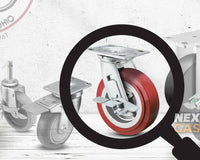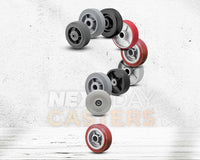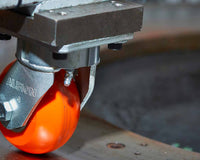The right caster can have a big impact on your business, employee safety, or satisfaction while using a mobile product. In this quick guide, we want to provide you with the basics to help you select the right size, wheel material, and brake type for your caster application. We will break things into various questions and provide links to related product solutions to keep this an easy and informative read.
Helpful hints to start:
- Use the links provided to jump start to a specific category in our store
- Smart filters are available on each category to help you quickly narrow down to the right size or feature you are looking for
Quick-Guide to Selecting the Right Caster
Below you will a summary that will guide you into the right category and wheel for your mobility needs, along with more detailed explanations for additional learning. Selecting the right caster is not always easy, and we are here to help. Please contact us if you would like support or can’t find what you are looking for. We offer thousands of additional solutions and are ready to help out!
Summary to selecting the right caster:
- Start by determining the minimum load capacity required per caster: take the maximum loaded weight of your cart/equipment and divide that by (the number of casters you will be using - 1); reasoning explained further below. This typically puts you into three main categories of casters:
- Capacities to 350 lbs. per caster – commonly known as 1.25” wide and 1” wide wheel casters (highly utilized casters for shopping carts, store fixtures, moving dollies, workstations, and more)
- Capacities from 350 - 1,250 lbs. per caster – commonly known as 2” wide wheel casters (highly utilized for industrial carts, warehouse trucks, and many other carts, racks, and material handling needs)
- Capacities over 1,250 lbs. per caster – commonly 2” wide kingpinless casters and 3” wide industrial casters (for heavy material handling and applications exposed to shock and impact)
- Review the flooring conditions your equipment will be regularly exposed to determine the best wheel choice (detailed wheel information and pros/cons further described in this post):
- Polypropylene for the least expensive mobility: water resistant, lightweight, but noisy and not easy to roll on rough surfaces or over debris
- Rubber includes (TPR) for floor protection, vibration dampening, and noise reduction—step up to polyurethane for greater durability
- Xtra-Soft Rubber for ultimate floor and cargo protection, debris rejection, best-in-class shock absorption, and quiet mobility
- Polyurethane (includes TPU) for floor protection, greater durability, and chemical/oil resistance
- Phenolic for high load ratings, durability, and inexpensive mobility
- Metal for highest load ratings and shock and impact resistance
- Select the size of the wheel: generally speaking, the larger the wheel, the easier it will roll (especially over any debris or thresholds) and the higher capacities you will find. 8” and 6” wheel diameter sizes are commonly used for platform and warehouse trucks because of this reason. 4” and 5” diameters will still handle great capacities and help you lower your overall product height; both are available in 1.25” wide and 2” wide wheels for varying degrees of required capacity. A lighter duty 3” x 1.25” wide caster is also available for lower profile mobility common in store fixtures and smaller equipment.
- Fastening or mounting choice determines how the caster will mount to your unit. Top plates are the most popular and preferred method due to durability, however you will find many light-to-medium duty applications with stem casters. NextDay Casters currently only offers top plate casters in the most common sizes, however a great variety of stem casters can be found on our sister site CasterSpecialists.com, another division of our company.
-
Brakes and accessories can be critical to the safety of your users. Selecting the right brake or cart floor lock can keep your products in place when you don’t want them moving:
- Side locking brakes activate from the side of the caster (on/off lever) and all feature a positive locking brake arm on this site to provide the best brake engagement for you
- Top locking brakes activate from the face or top part of the wheel tread, providing secure positive braking directly to the wheel
- Top total lock brakes lock both the swivel section of the caster and the wheel, ensuring that the product will not move in any direction regardless of wheel position when braked
Now for the detailed information. We hope that was a short but informative quick crash on the basics of selecting a caster. We will continue to add products and additional information regarding caster types and their purposes over the months to come.
More Information:
Casters are used in a variety of environments, from warehousing to food service, chemical production to schools; and each of these industries use casters on different equipment for different reasons. Given this, caster and wheel selection becomes a process of evaluating the load, the floor, the environment and the use.
Capacity Requirements
First, let’s start with the load. Calculating the load requirement is, of all the four areas, the most straightforward. When evaluating the load requirement, take the entire load, including the dead load of the cart, into consideration. Below is a basic formula for calculating caster capacity and beneath it are definitions of the variables.
(Product Load + Cart Weight) / (Number of Casters – 1) = Minimum Required Load Capacity per Caster Required
Conservatively, if four casters are being used, we always divide the total load of the cart by three (3), as opposed to four (4), as it takes only three points to make a plane. It is a very real concern that floors are not level and that one caster will not be in contact with the ground. Using a four wheel formula could cause premature failure of the casters. So let us start with a basic application, say a 2000 lb load, including the cart.
2000 lbs / 3 = 666.67 lbs ~ 675 lbs required per caster
We tend to round up the number to the nearest ten or twenty-five, as it is always better to have a slightly heavier duty caster as opposed to a slightly lesser duty to build in a higher safety factor. Higher capacity can generally be achieved by utilizing a wider tread width or a heavier duty rig or wheel.
In this scenario, a heavier duty polyurethane, phenolic, metal, or even an 8" performance Xtra-Soft rubber wheel would meet the requirements.
The Floor
Floor condition is considerably important when selecting the right wheel for a caster. Two conditions of the floor are of concern when selecting a caster: hardness and smoothness. Generally speaking, in regards to hardness and performance, the caster tread hardness should be opposite to the floor. So a hard floor needs a softer caster and a soft floor needs a harder caster. The smoothness of the floor helps narrow down possibilities as well. Again, generally speaking, a smoother floor can use a harder wheel and a rougher floor needs a softer wheel.
As already discussed above, each wheel provides different levels of floor protection. Floor protection, noise, and ease of mobility definitions can vary by each customer. If floor protection is even slightly important, consider using softer, more resilient materials; like polyurethane or thermoplastic/performance rubber wheels. Phenolic and polypropylene wheels also provide some floor protection in a harder, more rollable wheel, however they can be noisy and push debris around floors (damaging paint lines or tape) or easily get stuck on it.
The Environment
Every shop, plant, and store is different and, therefore, environmental requirements will vary greatly. Environmental concerns run from the very apparent like chemicals and water to the more subtle like noise and vibration.
In plant environments where water is present, such as food production or food service, wheels and rigs that will corrode in the presence of water should not be used. Consider using plastic wheels, stainless steel rigs and Delrin bearings. The same basic rules apply to chemical environments. If noise and vibration are of a concern, consider using a softer wheel material like rubber, polyurethane or thermoplastic rubber. In certain circumstances, like hospitals, you may find that a caster must be corrosion resistant, quiet and high temp.
Application
Caster usage encompasses several factors in the caster selection process. Issues like ease of starting, cart type, caster pattern, finished height, turn-ability and rollability, are part of the usage concerns.
First, rollability and ease of starting are determined, predominantly by the wheel tread material. For an easier to roll wheel, a harder tread should be used. However, the condition of the floor, floor protection and noise must be considered. Generally speaking, softer wheels are harder to start and roll less well. Consider, too, that even though a wheel can “handle” a load, it may not handle it well. Diameter becomes a factor with rollability and ease of starting. Smaller wheels are harder to turn than larger diameter wheels. Also, the wheel bearing will affect ergonomic rollability, precision ball bearings provide the best push/pull results.
Second, caster patterns and cart type as shown below, effect an influence caster specification. This will affect your rig selection, more than anything. Some carts need more swivel rigs than rigid, or vice versa. Below are some common mounting patterns for carts:

Thirdly, finished height is determined, generally, by the diameter of the wheel and the series of the caster. Customers may want a certain height for ergonomic, efficiency or look and feel reasons, to name a few.
Finally, steering; the ability to steer a caster is determined by its swivel lead, the difference in distance from the rear of the caster to the center of the kingpin. The longer this dimension, the easier the caster will be to steer. However, a cart with four swivel casters will not be very steerable. Remember that rigid caster are required for tracking purposes (unless used in combination with swivel locks, more on that below).
Important Dimensions
The top plate utilized can be a quick indicator to the product categories we previously discussed in the summary. Top plate dimensions are a critical to replacing a caster and are listed below:
- Outside Width
- Outside Length
- A&B Lengthwise Center to Center of Mounting Holes
- A&B Widthwise Center to Center of Mounting Holes
- Mounting Hole Bore Diameter
Brakes and Accessories
Casters with brakes play an important role in material handling and operational safety, ensuring equipment or materials do not move when you don't want them to. We provide a large selection of positive locking brake casters, meaning there is actual mechanical engagement on the wheel tread to ensure it holds. Available in side and top locking options, our standard brakes will secure only the wheel with a metal brake arm (some having a thermoplastic grip for greater grip, fully protected within the caster legs) and our total lock brake will secure both the wheel and the swivel section of the caster.
-
Side Locking Tread Brakes (TB)
- A tread brake has a lever on the side of the rig that engages a shoe that pulls down on the face of the wheel to prevent rotation. This is a very economical style of brake that positively engages with the wheel. Many NextDay Caster brakes also feature a thermoplastic brake grip on the shoe to add even better braking engagement, especially on harder wheels where the shoe can have a hard time gripping into.
-
Top Locking Face Contact Brake (FB)
- The face contact brake is becoming a very common brake option for casters. It is easy to operate and easy to see if it is engaged. It works by pressing against into face of the wheel, as the name implies. They are typically mounted on the trailing side of the caster (trails in the opposite way of being pushed, vs. leading which would face the way the cart is being pushed).
-
Total Lock Brakes (TL or TLB)
- A total lock brake is a top face contact brake that also has a swivel locking mechanism. Unlike a standalone swivel lock, a total lock brake works, typically, by raising a fork into the bottom of the swivel section while engaging a shoe on the wheel. The swivel section is specially notched completely around it to accept this. With the swivel section as well as the wheel brake locked, the swivel section is prevented from rotating. This is a critical brake in the medical industry and other industries where patient or user safety could be compromised by leaning against a mobile product or cart, causing falls that could results in injury.
-
Swivel Lock (SL)
- A swivel lock is helpful when moving large loads and locks free rotation of the swivel section for steering. They work by releasing a spring-loaded pin in to the swivel section (typically 4 positions notched on the caster swivel in 2” wide and 3” wide casters). They are either field installable like offered on NextDay Casters store, by bolting to the top plate, or welded on during original caster construction (contact us for welded swivel lock options).
-
Floor Locks
- Cart floor locks provide positive braking and locking to a mobile cart. By extending the floor lock, a rubber pad engages directly with the floor (the extended height is slightly larger to ensure positive engagement with the floor). Typically, only one floor lock is required when used with a swivel and rigid corner caster cart configuration (best placement is in between swivel casters), but floor locks can also be used in combination with all swivel and/or brake casters. When used with all swivel casters, two floor locks are recommended, placed on opposite sides along the longer sections of the cart. Our industrial floor locks are available in 4", 5", 6" (for both 7.25" and 7.5" caster heights), and 8" sizes. All feature a 4" x 4-1/2" top plate and are zinc plated.
Wheel Bearing Options
The right bearing can be critical to meeting your mobility performance objectives. There are many wheel bearing options, even just a plain bore that rides solely on the axle, but we will focus on the main bearing choices utilized in our store and across the industry:
-
Plain Bore (P):
- A plain bore bearing is not technically a bearing in itself. Plain bearing casters utilize the bored hub of a caster to allow for rotation. These tend to work only in lower capacity casters, as friction becomes a large issue with heavier loads.
-
Delrin Bearings (D):
- Delrin is a specialized plastic that is oil impregnated. These bearings allow for heavier loads than a plain bore, without adding much cost. They also tend to do well in cold and wet conditions, as there is no grease to wash away and less steel to rust. The bearings come in two styles, one and two piece. These bearings should not be greased, as the material already contains the lubrication.
-
Ball Bearings (B):
- Caster wheels with ball bearings allows for easier rollability, quiet operation, and reduction in lubrication maintenance. They are common in three types, industrial (not precision), precision with top hats and precision pedestal. An industrial, or non-precision, ball bearing is relatively inexpensive and is constructed of steel and they tend not to be sealed. A precision ball bearing (featured on NextDay Casters) is constructed of high-grade steel, which is precision machined to size. Precision ball bearings are sealed with a plastic gasket. Precision ball bearings are, by far, even easier to roll than a non-precision bearing and can handle even heavier loads. These bearings do not need to be greased.
-
Roller Bearings (R):
- Roller bearings are common in industrial casters (2” wide and 3” wide wheel casters). They are relatively economical and can handle relatively heavy loads. Roller bearings are made in three basic parts. First are the rollers, which are solid steel rod that are captured by, the second part, a plate on each end. Thirdly an outer race allows the rollers to spin freely in the wheel. These are typically held in the wheel by top hat spacers and the axle is typically enclosed in a spanner bushing. These bearings are not recommended for towing and must be greased on occasion.
Have questions or want to learn more? Contact us, we are happy to help.
We will continue adding to this post to keep it relevant and most impactful to you, our customer.





